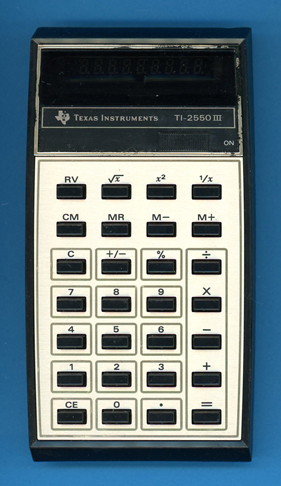
DATAMATH CALCULATOR MUSEUM
 |
DATAMATH CALCULATOR MUSEUM |
Texas Instruments TI-2550 III (Version 2)
| Date of introduction: | 1976 | Display technology: | Fluorescent |
| New price: | $29.95, £24.95 | Display size: | 8 |
| Size: | 5.8" x 3.2" x
1.3" 147 x 81 x 32 mm3 |
||
| Weight: | 6 ounces, 170 grams | Serial No: | 214528 |
| Batteries: | BP3 | Date of manufacture: | wk 40 year 1977 |
| AC-Adapter: | AC9130A | Origin of manufacture: | USA (MTA) |
| Precision: | Integrated circuits: | TMS1043 (ZA0352 BSP 7710) | |
| Memories: | Displays: | NEC LD8118L | |
| Program steps: | Courtesy of: | Joerg Woerner | |
| Download manual: | |

![]()
 The
TI-2550 III replaced within few month the TI-2550 II
which lacked the [+/-] key to change the sign of an entry. Unfortunately lacks
the TI-2550 III the
[F/2] switch of its predecessor.
The
TI-2550 III replaced within few month the TI-2550 II
which lacked the [+/-] key to change the sign of an entry. Unfortunately lacks
the TI-2550 III the
[F/2] switch of its predecessor.

 The featured TI-2550 III with Date code
4077 MTA was manufactured in
October 1977 by Texas Instruments in
their Midland, TX facility. Dismantling this TI-2550 III reveals a design centered
centered around a TMS1043 single-chip calculator circuit connected to a 9-digit
NEC LD8118L
Vacuum Fluorescent Display (VFD) and powered by a
BP3
battery pack with one AA-sized
rechargeable NiCd battery. Please notice that Texas Instruments designed the
calculator to accommodate the Itron FG95B1 VFD, too. We refer these models as
TI-2550 III (Version 1).
The featured TI-2550 III with Date code
4077 MTA was manufactured in
October 1977 by Texas Instruments in
their Midland, TX facility. Dismantling this TI-2550 III reveals a design centered
centered around a TMS1043 single-chip calculator circuit connected to a 9-digit
NEC LD8118L
Vacuum Fluorescent Display (VFD) and powered by a
BP3
battery pack with one AA-sized
rechargeable NiCd battery. Please notice that Texas Instruments designed the
calculator to accommodate the Itron FG95B1 VFD, too. We refer these models as
TI-2550 III (Version 1).
 Main driver for these design changes were obviously manufacturing costs,
comparing the printed circuit boards (PCBs) of the original TI-2550 II and its
successor TI-2550 III (Version 1) calculator reveals significant differences:
Main driver for these design changes were obviously manufacturing costs,
comparing the printed circuit boards (PCBs) of the original TI-2550 II and its
successor TI-2550 III (Version 1) calculator reveals significant differences:
| • Resistors to bias the VF Display integrated into TMS1043 • Power-up Clear integrated into TMS1043 • Capacitor for Clock Oscillator integrated into TMS1043 (Note: We observed on some TI-2550 III calculators a small 33pF capacitor soldered to the TMS1043, probably to calibrate its operating speed) |
In addition with removing one of the two AA-sized rechargeable
NiCd batteries found in the original BP2 battery pack the cost reductions added
up and similar electronics was used even with the
TI-1265.
![]()
 The TMS1043 is a member of the
TMS1040 Product Family based on the
TMS1070
"computer-on-a-chip" introduced in 1974 with the original
TMS1000.
While the TMS1070 can directly interface with low-voltage VFDs up to 35 Volts
does it still need external resistors and a zener diode to bias the anodes and
grids of the display with respect to the filament. The TMS1040 added an extra
VPP pin to connect a negative 30 Volts bias voltage for its modified
output drivers. With the TMS1070 featuring 11 R Outputs for the Digits, 8 O
Outputs for the Segments and 4 K Inputs for the Keyboard, reduced the TMS1040
the number of R Outputs to 9, consequently are all known TMS1040 calculator
designs using a 9-digit VF Display.
The TMS1043 is a member of the
TMS1040 Product Family based on the
TMS1070
"computer-on-a-chip" introduced in 1974 with the original
TMS1000.
While the TMS1070 can directly interface with low-voltage VFDs up to 35 Volts
does it still need external resistors and a zener diode to bias the anodes and
grids of the display with respect to the filament. The TMS1040 added an extra
VPP pin to connect a negative 30 Volts bias voltage for its modified
output drivers. With the TMS1070 featuring 11 R Outputs for the Digits, 8 O
Outputs for the Segments and 4 K Inputs for the Keyboard, reduced the TMS1040
the number of R Outputs to 9, consequently are all known TMS1040 calculator
designs using a 9-digit VF Display.
 Ever wondered
why we disassembled this TI-2550 III completely and desoldered its components? Learn
more about Characterization of Single-Chip Calculator Circuits with the
DCM-50A Platform.
Ever wondered
why we disassembled this TI-2550 III completely and desoldered its components? Learn
more about Characterization of Single-Chip Calculator Circuits with the
DCM-50A Platform.
A similar calculator chip was used with the innovative Canon MD-8
sporting a multi-line display.
The other changes were minor, the layout of the
keyboard was better organized.
This beautiful calculator was discontinued in 1977 and marks in most markets the end of the TI-2550 Product Family started in January 1974. In some European countries the rare TI-2550-IV extended its heritage for another year.
If you add the [pi] key to this calculator you get the Canon Palmtronic F-31 or Toshiba BC-8112SL. A more compact design was introduced with the Canon Palmtronic LD-8Ms.
If you have additions to the above article please email: joerg@datamath.org.
© Joerg Woerner, January 6, 2022. No reprints without written permission.